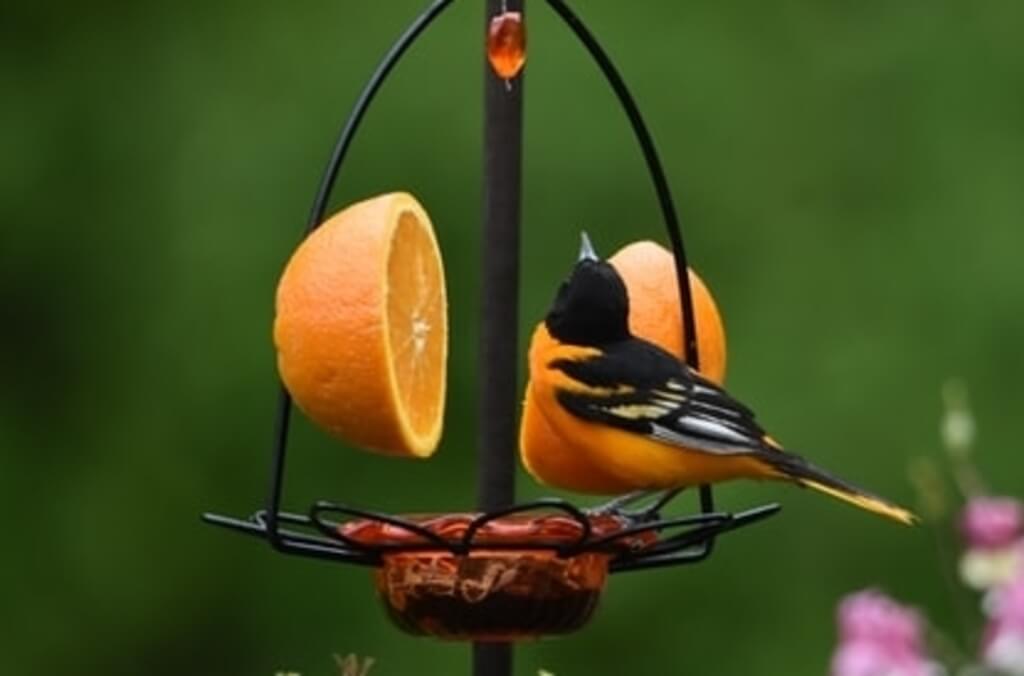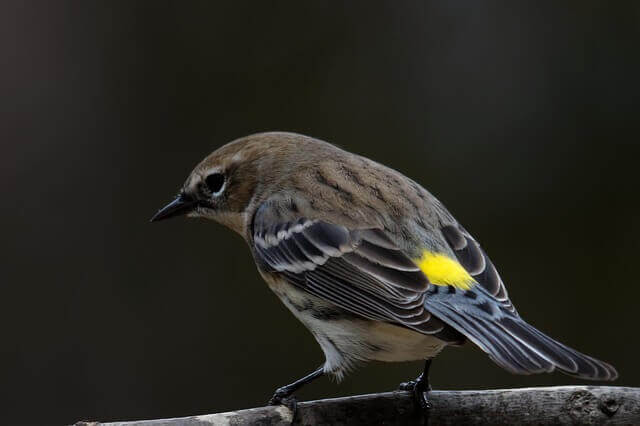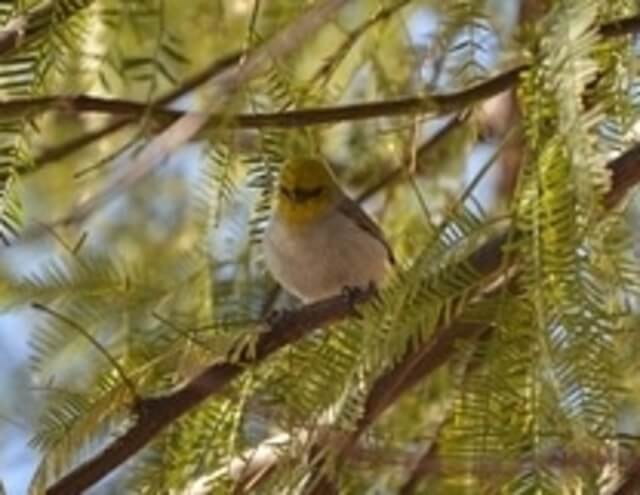Birds are a backyard visitor that many people love to watch and feed. One easy and popular way to attract birds is to offer grape jelly. This guide will show you 25 different types of birds that love to eat grape jelly, along with some identification tips and a recipe for homemade grape jelly. So grab your binoculars, and get ready to enjoy some feathered friends!
Table of Contents
- 1 Tips for Feeding Birds Jelly
- 2 Why Birds Love Grape Jelly? The Science Behind it
- 3 Birds That Eat Grape Jelly
- 3.1 Baltimore Oriole
- 3.2 Gray Catbird
- 3.3 Rose-breasted Grosbeak
- 3.4 Black-headed Grosbeak
- 3.5 Yellow-rumped Warbler
- 3.6 Orange-crowned Warbler
- 3.7 Cape May Warbler
- 3.8 Hairy Woodpecker
- 3.9 Downy Woodpecker
- 3.10 Red-bellied Woodpecker
- 3.11 Brown Thrasher
- 3.12 Scarlet Tanager
- 3.13 Western Tanager
- 3.14 House Finch
- 3.15 Cassin’s Finch
- 3.16 Northern Mockingbird
- 3.17 American Robin
- 3.18 Cedar Waxwing
- 3.19 European Starling
- 3.20 Northern Cardinal
- 3.21 Verdin
- 3.22 Orchard Oriole
- 3.23 Bullock’s Oriole
- 3.24 Hooded Oriole
- 3.25 Scott’s Oriole
- 4 Frequently Asked Questions
- 4.1 How to make grape jelly for birds?
- 4.2 Why do birds eat grape jelly?
- 4.3 How can I attract birds to my yard?
- 4.4 Do hummingbirds like grape jelly?
- 4.5 What gray bird eats grape jelly?
- 4.6 What birds are attracted to oriole feeders?
- 4.7 Do robins eat grape jelly?
- 4.8 Do sparrows eat grape jelly?
- 4.9 Do house finches eat grape jelly?
- 4.10 Can birds eat too much jelly?
- 4.11 Do catbirds eat grape jelly?
- 4.12 Can orioles eat regular grape jelly?
- 4.13 Do wrens like grape jelly?
- 4.14 Do bluebirds like grape jelly?
- 4.15 Do blue jays like grape jelly?
- 4.16 Do chickadees like grape jelly?
- 4.17 Do yellow finches like grape jelly?
- 4.18 Do purple finches like grape jelly?
- 4.19 Do woodpeckers like grape jelly?
- 5 Author
Tips for Feeding Birds Jelly
When it comes to setting up a jelly feeder, there are a few things to keep in mind. First, choose a feeder that is specifically designed for jelly or fruit, as these will have the right size and shape to hold the jelly and keep it from spilling.
Look for a feeder that is made of easy-to-clean materials, such as plastic or glass, so that you can remove any leftover jelly or debris between feedings. Additionally, choose a location for your feeder that is away from any windows or reflective surfaces that could confuse birds, and in a spot that is easy for you to observe and refill.
Finally, be patient: it may take a few days or weeks for birds to discover your new feeder, so don’t give up if you don’t see any visitors right away.
Why Birds Love Grape Jelly? The Science Behind it
Birds are attracted to grape jelly for a few reasons, one of which is the high sugar content. Like most animals, birds have a natural craving for sweet things, and the high sugar content of grape jelly satisfies that craving.
Additionally, grape jelly has a similar texture and color to the fruit flies and other insects that many bird species eat, which makes it an attractive alternative when those insects are scarce.
Some experts also suggest that the bright color of grape jelly may make it more visible to birds, especially during times of low light or poor weather conditions. Overall, the combination of sweetness and mimicry makes grape jelly an irresistible treat for many bird species.
Birds That Eat Grape Jelly
Baltimore Oriole
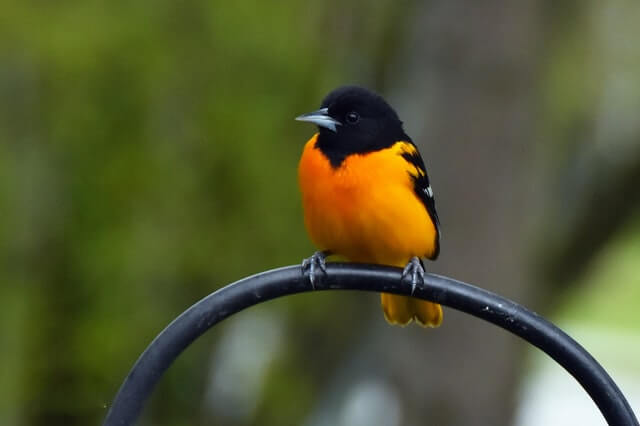
Baltimore Orioles are often spotted in North America. The Baltimore Oriole range includes the eastern United States, southern Canada and parts of Mexico. They prefer to nest in forested areas or hedges, but will also inhabit residential neighborhoods with tall trees.
Their diet consists mainly of insects and fruit, but they also enjoy nectar from flowers such as milkweed plants and trumpet vines. Attract these beautiful birds to your yard with an oriole feeder with oranges and grape jelly.
Related Post: Baltimore Oriole Bird Facts (with Photos, ID & Info)
Gray Catbird
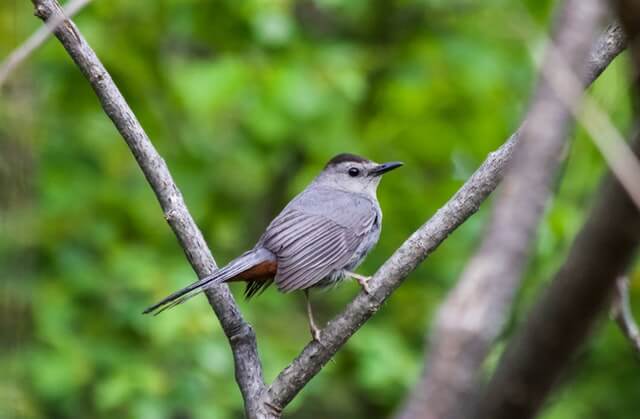
The Gray Catbird is a small songbird that can be found in the eastern United States and Canada. The range of this bird includes most of the eastern half of North America, as well as some southern parts of Central America.
Their habitat ranges from forests, shrublands, marshes and other wetland areas. Their diet consists mainly of insects such as caterpillars, beetles and ants, but they also eat seeds, berries and fruits.
Rose-breasted Grosbeak
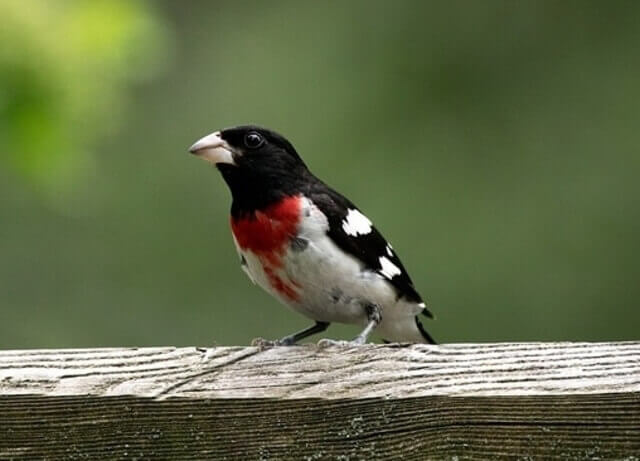
The Rose-breasted Grosbeak is a medium-sized songbird that inhabits most of North America. It can be found in the Eastern and Central United States, with populations extending west to the Great Plains.
It eats mostly insects and fruits, but will also consume berries and seeds when available. Rose-breasted Grosbeaks live in many habitats such as coniferous forests, prairies, orchards, parks and gardens.
Related Post: How To Attract Rose-breasted Grosbeak: The Easiest Way!
Black-headed Grosbeak
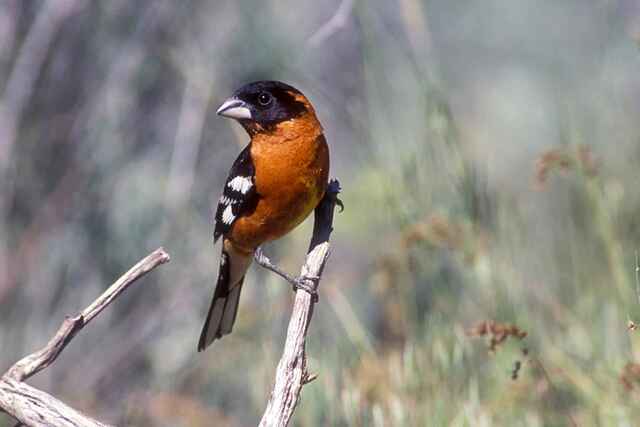
The Black-headed Grosbeak is a bird that can be found in the southeastern United States. The range of this species is from eastern North Carolina to northern Florida and west to east Texas.
They live primarily in forested areas, but are also known to visit gardens or yards where there are trees for them to eat seeds from or drink nectar from flowers. Black-headed Grosbeaks spend their time perched high up on tree branches.
Yellow-rumped Warbler
The Yellow-rumped Warbler is a common warbler that breeds in eastern North America and winters in Central America. They are migratory birds, so they spend the winter season traveling south to escape the cold weather.
Yellow-rumped Warblers eat mainly insects, but will also eat berries and seeds. They like open areas with trees or shrubs for nesting. Their habitat ranges from coastlines to forests, parks and backyards!
Related Post: How to Attract Yellow Warblers to your Backyard Fast?
Orange-crowned Warbler
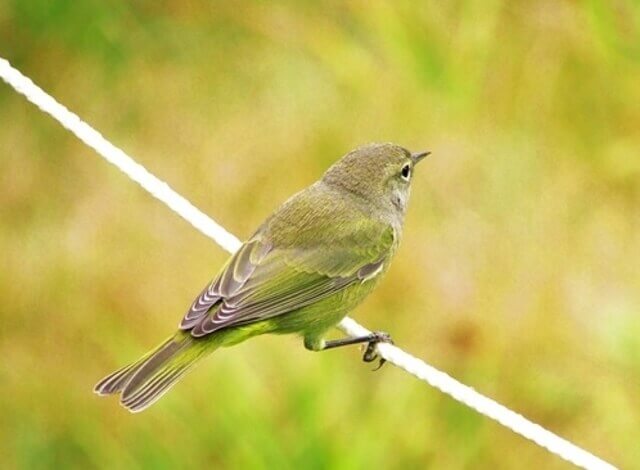
The Yellow-rumped Warbler is a common bird in North America. The species ranges from southern Canada, United States, to Central America, and as far south as northern South America.
It lives in deciduous forests, mixed woodlands, swamps and thickets of cattails. It feeds on insects such as beetles, grasshoppers and crickets which it gleans or catches while perched or hovering close to the ground.
Related Post: How to Attract Warblers to your Yard? (Expert Tips)
Cape May Warbler
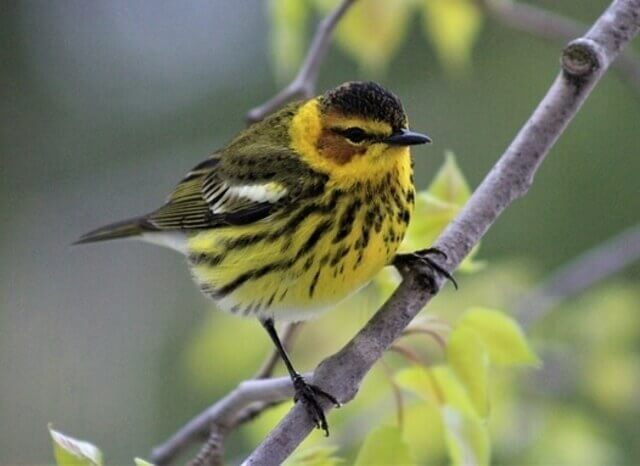
The Cape May Warbler is a small, songbird that breeds in North America. They are found in the Eastern United States and southern Canada from Maine to eastern Kansas, south to Florida and northern Mexico.
It lives mostly near marshes, swamps, forest edges with open areas where it can feed on fruit, berries, insects such as mosquitoes. The species eats mostly insects including grasshoppers, flies, and beetles which it catches by gleaning or hawking from leaves or branches.
Hairy Woodpecker
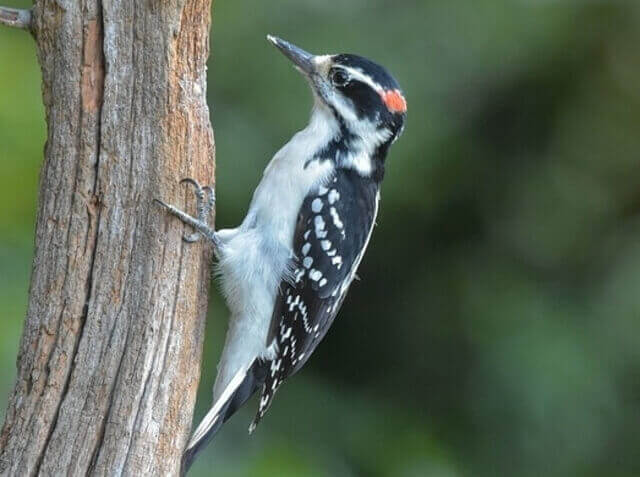
The Hairy Woodpecker is a small-sized woodpecker found in the North American continent. They range from Alaska to New England and have been spotted as far south as Texas.
The habitat of this bird can be found anywhere there are trees, shrubs, or large plants that can provide shelter for it and its nest. Hairy Woodpeckers eat primarily insects, but will also consume some fruit if it is available.
Downy Woodpecker
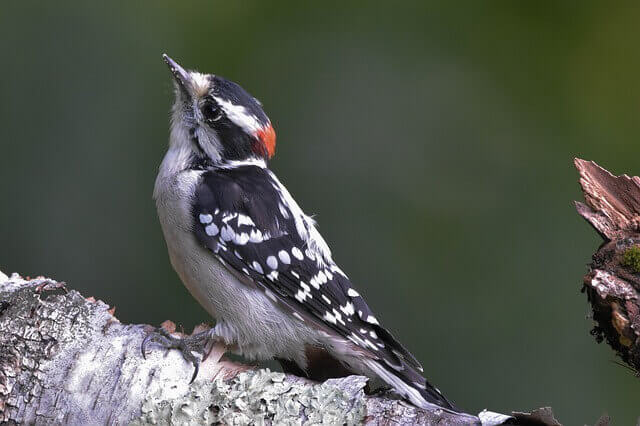
Downy Woodpeckers are small birds with a wide range, habitat and diet. They have the widest range of any North American woodpecker. These woodland creatures can be found in forests across Canada and south to Panama, as well as in most of the US except for Alaska.
They eat bugs such as ants, beetles and caterpillars, but also fruits like berries or apples that they find on trees. They often forage on trees for these items by climbing up or clinging to the trunk of the tree with their claws while they look around for food.
Related Post: How to Attract Downy Woodpeckers to Your Yard? (Easy!)
Red-bellied Woodpecker
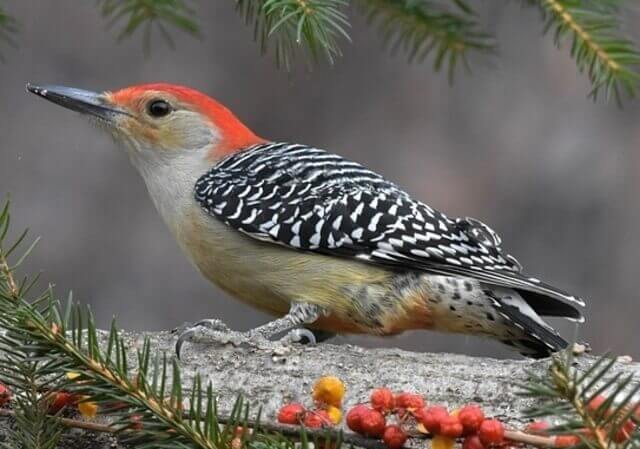
Red-bellied Woodpeckers are a native species of woodpecker in North America. They range from Eastern Canada to the southern United States, excluding Mexico and Central America. They inhabit deciduous forests, pine woods, parks and backyards as well as swamps, lakesides and stream banks.
The Red-bellied Woodpecker has been observed foraging on insects in trees or in lawns where they will dig shallow holes looking for grubs or ants under the turf surface.
Related Post: How to Attract Red-bellied Woodpeckers to your Yard?
Brown Thrasher
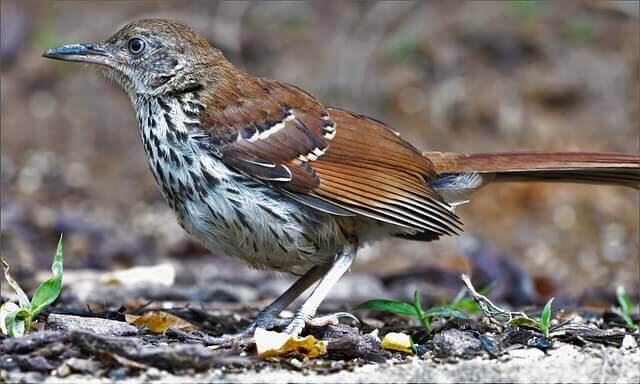
Brown thrashers are native to North America and inhabit the eastern coast of Canada, south through Florida and west through Texas. They also live in many states across the United States.
They can be found in many different types of habitats including forests, swamps, wetlands and marshes. Brown thrashers mainly eat invertebrates, such as insects and spiders, but they will also eat seeds and fruit.
Scarlet Tanager

Scarlet Tanagers are medium-sized songbirds that live in the eastern half of North America. They can be found in forested areas, but they also visit suburban neighborhoods to eat suet and fruit.
These birds have a beautiful scarlet-red coloration on their breasts, wings and heads which is most visible during breeding season when males gather with females for courtship displays. Scarlet Tanagers prefer insects such as beetles, caterpillars and ants; but will also eat fruits like blackberries or cherries and grape jelly.
Related Post: How To Attract Scarlet Tanagers To Your Backyard Fast?
Western Tanager
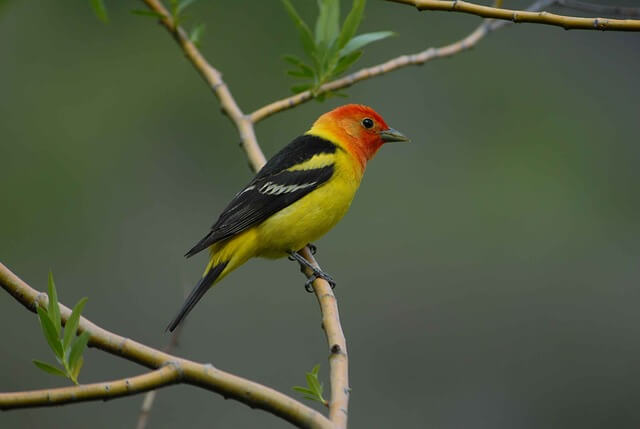
Western Tanagers are the most common species of tanager in North America. They have a natural range throughout the western United States and Canada, with a range that extends south to Panama.
The Western Tanager makes its habitat in woodlands, thickets and edges of woods with a large variety of trees. The Western Tanager is an omnivore and eats a variety of insects, berries, nectar, fruits and other plant material.
Related Post: How to Attract Western Tanager to your Yard? Expert Tips!
House Finch

The House Finch is a type of finch that belongs to the Fringillidae family. House Finch’s natural habitat is the eastern United States and southern Canada.
They are usually found in the open areas of suburban yards, parks, and forests with a lot of trees. Their diet consists mainly of seeds, berries and grains such as corn, sunflower seeds, millet, oats and wheat.
Related Post:
- How to Attract House Finch to your Yard? (Easy & Fast)
- 9 Best Birdhouse for Finches? (Rated & Tested for 2022)
Cassin’s Finch

The Cassin’s Finch is a common bird in the Western United States. It is found from southern British Columbia, across the Rocky Mountains and into New Mexico.
It lives in various habitats such as coniferous forests, shrublands, riparian areas and meadows. The diet of Cassin’s Finch consists mainly of plant matter, seeds, berries and insects which it finds on or near the ground.
Northern Mockingbird

The Northern Mockingbird has a range from Canada, across the United States, and into Central America. They prefer to live in habitats with a variety of trees, shrubs, vines and other vegetation.
The Northern Mockingbird’s diet consists mostly of insects and berries but they will also eat seeds when food is scarce. Mockingbirds typically mate for life but males can have multiple mates during breeding season.
Related Post: How to Attract Mockingbirds to your Yard? (Expert Tips)
American Robin

The American Robin is a small songbird native to North America. The American Robin’s range stretches from the northern United States and southern Canada to Central America, with its habitat primarily in deciduous woodlands and farmland.
Its diet consists of worms, snails, insects, fruit (especially blackberries), and other invertebrates.
Related Post:
- 5 Best Bird Feeders For Robins (Tested & Rated For 2022)
- How To Attract Robins To Your Yard – 7 Best Tips!
- Birds That Look Like Robins But Aren’t
Cedar Waxwing
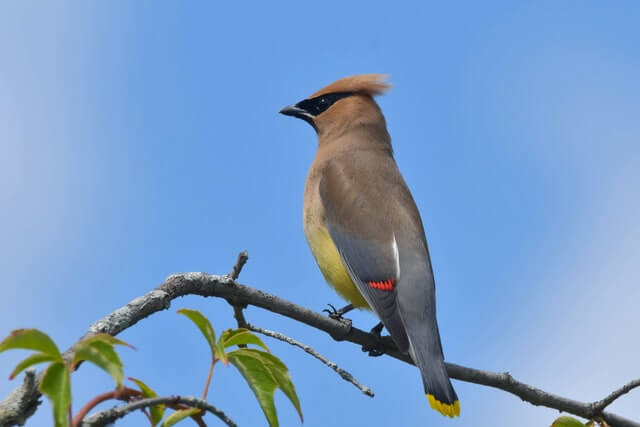
The Cedar Waxwing is a small songbird that has been expanding its range. They are typically found in eastern North America, with the majority of sightings occurring between Canada and Mexico. The cedar waxwing’s habitat includes areas such as forest edges, parks, and residential neighborhoods.
This species prefers to nest in the holes of trees or on cliffsides high above ground level. They eat mainly insects, but will also consume berries and fruits when available.
Related Post: How to Attract Cedar Waxwings to your Yard (Experts Tips)
European Starling
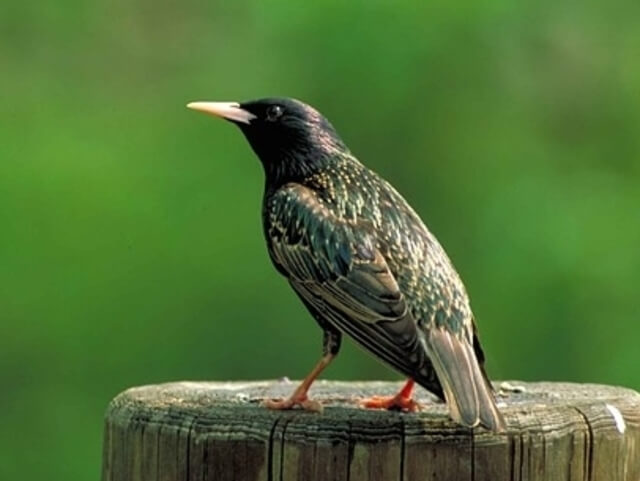
The European Starlings range spans from Ireland and Spain to the eastern coasts of Russia. They are also found in Africa, Asia, Australia, and North America. The European Starlings can be found in a variety of habitats ranging from forests to farmlands to urban areas.
European starlings eat mostly insects such as beetles and caterpillars but will also feed on other small animals such as mice or lizards if they have the opportunity. They will also eat seeds and fruit that have fallen on the ground.
Related Post: How To Attract European Starlings To Your Yard Fast?
Northern Cardinal

Northern Cardinals are a beautiful bird that lives in the northern United States. The Northern Cardinal is most commonly found in the eastern half of North America, but they can also be found as far west as Arizona and Mexico.
They have a wide variety of habitats that they inhabit such as woodlands, open areas with trees or bushes for cover, parks or gardens. They have a diet consisting mostly of insects but will also eat seeds, berries, fruits, nuts and other types of food.
Related Post:
- 10 Best Bird Feeders for Cardinals (Rated for 2022)
- 11 Birds That Look Like Cardinals (with Photos and Info)
Verdin
The Verdin is a medium-sized bird that lives in the southwestern United States and Mexico. The range of this species extends from eastern Texas to western New Mexico, Arizona, and southern California. The Verdin can be found at elevations between 2,000 to 8,500 feet above sea level.
The habitats for the Verdin are deserts scrublands or oak woodlands with dense underbrush where they search for their food. They primarily eat seeds from plants like sunflowers or insects that they find on the ground. They can also be seen eating berries and fruit from trees, such as pinyon pine.
Orchard Oriole

The Orchard Oriole is a small black and orange bird. The male has a black head, back, and tail with an orange chest and belly. The female is mostly orange with some black on her wings. They are found in eastern North America and Canada. They feed primarily on insects, fruits, and berries. You may attract them to your yard by putting out grape jelly or fruit.
Orchard Orioles are most often found in woodlands near streams or other water sources, but they will also visit yards and gardens. They eat mainly insects, but also enjoy fruits and berries. To attract Orchard Orioles to your yard, put out a dish of grape jelly or fresh fruit such as oranges or apples.
Bullock’s Oriole
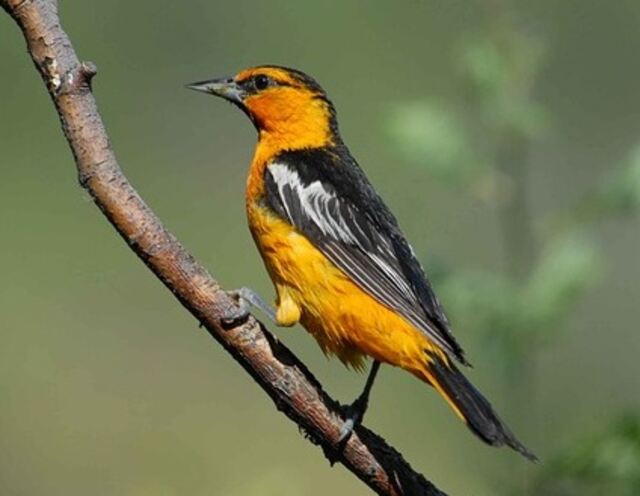
The Bullock’s Oriole is a beautiful bird that is found in North America. The male has black and yellow plumage, while the female is mostly yellow with some black on her wings. These birds are most commonly found in the western United States and Mexico, but they have been known to range as far east as Manitoba, Canada. Their habitats include open woodlands, parks, and gardens.
Bullock’s Orioles eat a variety of insects, fruits, and berries. They are especially fond of grape jelly! To attract these lovely birds to your yard, simply put out a dish of grape jelly or place a few grapes where they can see them. You may even be lucky enough to see these birds nesting in your trees!
Hooded Oriole
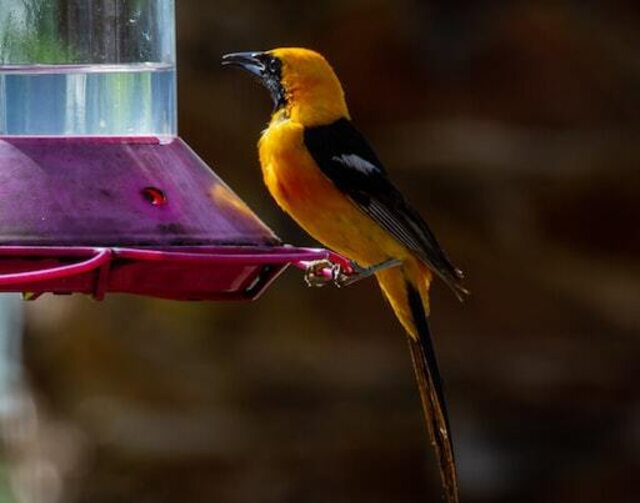
The Hooded Oriole is a beautiful bird that is found in the southwestern United States. They are most commonly seen in Texas, but their range extends into Oklahoma, Louisiana, and Arkansas. The Hooded Oriole is a small bird with a black mask and orange head and breast. They have a white patch on their wings, and their tail is long and black.
Hooded Orioles are found in open woodlands near streams or other water sources. They build their nests in trees, often in palms or sycamores. Hooded Orioles eat insects and spiders, as well as fruit and nectar. They will also come to bird feeders to eat grape jelly or oranges. To attract Hooded Orioles to your yard, put out a dish of grape jelly or an orange cut in half.
Scott’s Oriole

The Scott’s Oriole is a beautiful bird that is found in the southwestern United States. They are most commonly seen in Arizona, New Mexico, and Texas. These birds are known for their striking orange and black plumage. The males are especially colorful, with a black hood and wings and orange throughout. The Scott’s Oriole is a medium-sized bird, measuring about nine inches in length.
These birds typically inhabit open woodlands and desert scrub habitats. They can also be found in urban areas, such as parks and gardens. The Scott’s Oriole feeds primarily on insects, but they will also eat fruits and berries. Grape jelly is a favorite food of these birds, so if you’re looking to attract them to your backyard, be sure to put out some grape jelly!
Frequently Asked Questions
How to make grape jelly for birds?
If you want to make your own grape jelly at home, the healthiest way is to use crushed red grapes or concord grapes with no sugar added. Simply set out a tray or dish with the grapes in it, and the jelly will form on its own. The depth of the tray or dish should be about 1 inch, and the width should be about 4 inches. This method is also great for attracting birds to your backyard!
Why do birds eat grape jelly?
Birds commonly eat grapes and berries that are left over from harvesting. The sweetness in these foods can act as an energy booster, allowing for them to survive long periods without eating. But be careful, and only use this as an occasional treat, because too much sugar can cause a bird health problems.
How can I attract birds to my yard?
The idea of attracting birds to my yard with grape jelly might sound silly, but it is surprisingly effective. I have been using this technique for many years now and I am happy to report that it always works wonderfully! The sugars in jelly are irresistible to most birds.
- Put some grape jelly on a saucer or plate and place in the center of your lawn.
- Add slices of apples or oranges to the plate as well.
- Make sure there are no other food sources available within your yard like seed feeders.
Do hummingbirds like grape jelly?
Do hummingbirds like grape jelly? Yes they do. Hummingbirds have a sweet tooth and can be lured by sweet foods such as grapes, sugar water, and fruit juice.
Some other common methods to attract hummingbirds are placing flowers or sugary substances near your house or setting up feeders with their favorite nectar solution.
What gray bird eats grape jelly?
The gray catbird is a common songbird in North America. This bird can be found in many habitats, including forests, scrub lands, and suburban yards.
The gray catbird will eat most types of food such as fruit (especially grapes), berries, nuts, and insects. They also like to eat grape jelly on occasion!
What birds are attracted to oriole feeders?
The most common birds attracted to oriole feeders are tanagers, northern mockingbirds, finches, grosbeaks, and woodpeckers.
One way to help attract these species is by making sure that your oriole feeder is orange. You can also add meal worms and grape jelly to the mix for even more diversity in species.
Do robins eat grape jelly?
Robins are omnivores and will eat almost anything. They will feed on a variety of foods, including insects, worms, and grapes. They have also been known occasionally eat grape jelly if it is available to them.
Do sparrows eat grape jelly?
Many people think that sparrows do not eat grape jelly. This is a common misconception, as many sparrows love to eat grape jelly and other sweet foods.
Grape Jelly contains sugar, which is something that sparrows consume in order to provide them with energy and power their bodies.
Do house finches eat grape jelly?
House finches are omnivores and eat a variety of foods such as seeds, fruit, insects, leaves, nectar, etc. There is no doubt that they will also enjoy eating some delicious grape jelly if you give the opportunity!
Can birds eat too much jelly?
Birds should only be fed grape jelly occasionally as a treat. Jelly is a type of sweet food made from fruit juice and sugar. The issue is that jelly contains more sugar than most fruits and should not be fed to birds all the time, because it can give them health problems.
Do catbirds eat grape jelly?
The Catbird is a type of bird that many people have never heard of. It lives in North America and eats mostly fruit. The Catbirds eat both jelly and grapes but they prefer the latter more. They do enjoy eating grape jelly though!
Can orioles eat regular grape jelly?
A common question people ask is if orioles can eat regular grape jelly. It’s possible for them to, but it would not be recommended. Regular grape jelly has a lot of sugar in it and some other things that could make the bird sick or even kill them. If you want to feed an oriole something that is safe for them, try making your own homemade puréed fruit
Do wrens like grape jelly?
Of course, they like grape jelly. Wrens are small birds that eat insects and love to feed on fresh fruit. Grape jelly is a perfect food for them because it has lots of sugar, fat, and carbs which they need to survive.
Do bluebirds like grape jelly?
Do bluebirds like grape jelly? This is a question that has been asked by many people. It seems to be an age-old debate, but the answer is yes! Bluebirds do in fact enjoy eating grape jelly.
I have found this to be true while watching them as they feed on my bird feeder. It is such a pleasure to watch them soar and then land right near the jelly filled tray.
Do blue jays like grape jelly?
The blue jay is a native North American bird. It is the only songbird in Canada that can be found throughout the country year-round. Blue jays are not just beautiful birds, they are also inquisitive and clever. They will feed on a variety of foods to supplement their diet, including grape jelly.
Do chickadees like grape jelly?
Chickadees are often seen eating from the feeders of birdwatchers. Some people wonder if they enjoy their grape jelly as much as we do, and it turns out that chickadees have a sweet tooth for fruit-flavored jellies.
The majority of wild birds will eat insects and seeds when in season, but grapes seem to be one of their favorite treat’s year round.
Do yellow finches like grape jelly?
Yellow finches are commonly found in North America and Europe. It is often a popular belief that yellow finches only eat seeds, but this is not true. The diet of the yellow finch includes nectar, insects, eggs, fruit and other types of food.
Grape jelly has been seen as an occasional treat for people to consume because it contains sugar, which provides them with energy.
Do purple finches like grape jelly?
Purple finches are a common sight in many people’s backyards, but do they enjoy the occasional treat of grape jelly? It turns out that some bird watchers have noticed that the birds seem to really enjoy their daily serving of fresh grapes, or even some grape jelly on occasion.
Do woodpeckers like grape jelly?
Woodpeckers are always looking for sweet foods to eat. They will fly up into trees and tap on the trunk until they find something that has a high sugar content, such as pine sap or nectar from flowers. They will gladly peck away at a jar of grape jelly for hours on end, until it is all gone.
Related Post: Where Should Oriole Feeders Be Placed? (The Best Spots!)

